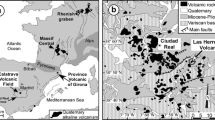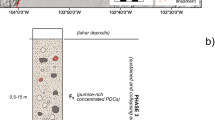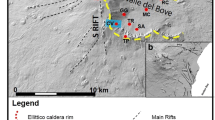Abstract
The standard model of caldera formation is related to the emptying of a magma chamber and ensuing roof collapse during large eruptions or subsurface withdrawal. Although this model works well for numerous volcanoes, it is inappropriate for many basaltic volcanoes (with the notable exception of Hawaii), as these have eruptions that involve volumes of magma that are small compared to the collapse. Many arc volcanoes also have similar oversized depressions, such as Poas (Costa Rica) and Aoba (Vanuatu). In this article, we propose an alternative caldera model based on deep hydrothermal alteration of volcanic rocks in the central part of the edifice. Under certain conditions, the clay-rich altered and pressurized core may flow under its own weight, spread laterally, and trigger very large caldera-like collapse. Several specific mechanisms can generate the formation of such hydrothermal calderas. Among them, we identify two principal modes: mode 1: ripening with summit loading and flank spreading and mode II: unbuttressing with flank subsidence and flank sliding. Processes such as summit loading or flank subsidence may act simultaneously in hybrid mechanisms. Natural examples are shown to illustrate the different modes of formation. For ripening, we give Aoba (Vanuatu) as an example of probable summit loading, while Casita (Nicaragua) is the type example of flank spreading. For unbuttressing, Nuku Hiva Island (Marquesas) is our example for flank subsidence and Piton de la Fournaise (La Réunion) is our example of flank sliding. The whole process is slow and probably needs (a) at least a few tens of thousands of years to deeply alter the edifice and reach conditions suitable for ductile flow and (b) a few hundred years to achieve the caldera collapse. The size and the shape of the caldera strictly mimic that of the underlying weak core. Thus, the size of the caldera is not controlled by the dimensions of the underlying magma reservoir. A collapsing hydrothermal caldera could generate significant phreatic activity and trigger major eruptions from a coexisting magmatic complex. As the buildup to collapse is slow, such caldera-forming events could be detected long before their onset.










Similar content being viewed by others
References
Acocella V, Cifelli F, Funiciello R (2000) Analogue models of collapse calderas and resurgent domes. J Volcanol Geotherm Res 104:81–96
Ando M (1979) The Hawaii earthquake of November 29, 1975: low dip angle faulting due to forceful injection of magma. J Geophys Res 84:7616–7626
Bachèlery P (1981) Le Piton de la Fournaise (Ile de la Réunion). Etude volcanologique, structurale et pétrologique. Ph.D. thesis, University of Clermont-Ferrand, Clermont-Ferrand
Bachèlery P (2007) Fournaise: l’éruption du siècle. Eruption 15:19–21
Bachèlery P, Mairine P (1990) Evolution volcano-structurale du Piton de la Fournaise depuis 0.53 Ma. In: Lénat J-F (ed) Le volcanisme de la Réunion—Monographie. Cent Rech Volcanol, Clermont-Ferrand, pp 213–242
Barde-Cabusson (2007) Formation de caldera par fluage d’un système hydrothermal volcanique. Ph.D. thesis, University of Clermont-Ferrand, Clermont-Ferrand
Barde-Cabusson S, Merle O (2007) From steep-slope volcano to flat caldera floor. Geophys Res Lett 34:L10305. doi:10.1029/2007GL029784
Bindemann I, Valley JW (2000) Formation of low-δ18O rhyolites after caldera collapse at Yellowstone, Wyoming, USA. Geology 28:719–722
Borgia A (1994) Dynamic basis for volcanic spreading. J Geophys Res 99:17791–17804
Borgia A, Burr J, Montero W, Morales LD, Alavarado GE (1990) Fault propagation folds induced by gravitational failure and slumping of the Central Costa Rica Volcanic Range: implications for large terrestrial and Martian volcanic edifices. J Geophys Res 95:14357–14382
Branney MJ, Kokelaar P (1994) Volcanotectonic faulting, soft state deformation, and rheomorphism of tuffs during development of a piecemeal caldera, English Lake District. Geol Soc Am Bull 106:507–530
Briole P, Bachèlery P, McGuire B, Moss J, Ruegg JC, Sabourault P (1998) Deformation of Piton de la Fournaise: evolution of the monitoring techniques and knowledge acquired in the last five years. In: Casale R et al (eds) Proceedings of the 2nd Workshop on European Laboratory Volcanoes, Santorini, Greece, 1996, European Commission, Brussels, pp 467–474
Calvari S, Spampinato L, Lodato L (2006) The 5 April 2003 vulcanian paroxysmal explosion at Stromboli volcano from field observations and thermal data. J Volcanol Geotherm Res 149:160–175
Carrasco-Nunez G, Vallance JW, Rose WI (1993) A voluminous avalanche-induced lahar from Citlaltepelt volcano, Mexico: implications for hazard assessment. J Volcanol Geotherm Res 59:35–46
Cecchi E (2003) Reconstruction 3D pour la volcanologie: apports d’une méthode multi-vues par photogrammétrie numérique. Ph.D. thesis, University of Clermont-Ferrand, Clermont-Ferrand
Cecchi E, van Wyk de Vries B, Lavest JM (2005) Flank spreading and collapse of weak-cored volcanoes. Bull Volcanol 67:72–91
Day SJ (1996) Hydrothermal pore fluid pressure and the stability of porous, permeable volcano. In: McGuire WJ, Jones AP, Neuberg J (eds) Volcano instability on the earth and other planets. Geol Soc Lond Spec Publ 110:77–93
Delaney PT, Denliger RP, Lisowsky M, Miklius A, Okubo PG, Okamura AT, Sako MK (1998) Volcanic spreading at Kilauea, 1976–1996. J Geophys Res 103:18003–18023
Dieterich JH (1988) Growth and persistence of Hawaiian volcanic rift zones. J Geophys Res 12:147–160
Donnadieu F, Merle O (1998) Experiments on the indentation process during cryptodome intrusion: new insights into Mt St Helens deformation. Geology 26:79–82
Donnadieu F, Merle O, Besson JL (2001) Volcanic edifice stability during cryptodome intrusion. Bull Volcanol 63:61–72
Druitt TH, Sparks RS (1984) On the formation of calderas during ignimbrite eruptions. Nature 310:679–681
Elsworth D, Day S (1999) Flank collapse triggered by intrusion: the Canarian and Cape Verde Archipelagoes. J Volcanol Geotherm Res 94:323–340
Finizola A, Sortino F, Lénat J-F, Valenza M (2002) Fluid circulation at Stromboli volcano (Aeolian Islands, Italy) from self potential and CO2 surveys. J Volcanol Geotherm Res 116:1–18
Finizola A, Lénat J-F, Macedo O, Ramos D, Thouret J-C, Sortino F (2004) Fluid circulation and structural discontinuities inside Misti volcano (Peru) inferred from self-potential measurements. J Volcanol Geotherm Res 135:343–360
Finizola A, Revil A, Rizzo E, Piscitelli S, Ricci T, Morin J, Angeletti B, Mocochain L, Sortino F (2006) Hydrogeological insights at Stromboli volcano (Italy) from geoelectrical, temperature, and CO2 soil degassing investigations. Geophys Res Lett 33:L7304. doi:10.1029/2006GL026842
Firth C, Stewart L, McGuire WJ, Kershaw S, Vita-Finzi C (1996) Coastal elevation changes in eastern Silicy: implications for volcano instability at Mount Etna. In: McGuire WJ, Jones AP, Neuberg J (eds) Volcano instability on the earth and other planets. Geol Soc Lond Spec Publ 110:153–167
Frank D (1995) Surficial extent and conceptual model of hydrothermal system at Mount Rainier. J Volcanol Geotherm Res 65:51–80
Galland O, Cobbold PR, Hallot E, de Bremond d’Ars J, Delavaud G (2006) Use of vegetable oil and silica powder for scale modelling of magmatic intrusion in a deforming brittle crust. Earth Planet Sci Lett 243:786–804
Gillott JE (1987) Clay in engineering geology. Developments in geotechnical engineering. Elsevier Science, Amsterdam
Gillot PY, Nativel PE, Condomines M (1990) Géochronologie du Piton de la Fournaise. In: Lénat J-F (ed) Le volcanisme de la Réunion—Monographie. Cent Rech Volcanol, Clermont-Ferrand, pp 243–256
Glicken H, Voight B, Janda RJ (1981) Rockslide–debris avalanche of May 18, 1980, Mount St. Helens volcano. Proceedings of the IAVCEI Symposium on Arc Volcanism, Tokyo and Hakone, pp 109–110
Hall ML, Robin C, Beate B, Mothes P, Monzier M (1999) Tungurahua volcano, Ecuador: structure, eruptive history and hazards. J Volcanol Geotherm Res 91:1–21
Hildreth W, Halliday AN, Christinsen RL (1991) Isotopic and chemical evidence concerning the genesis and contamination of basaltic and rhyolitic magma beneath the Yellowstone Plateau Volcanic Field. J Petrol 32:63–138
Hochstein MP, Browne PRL (2000) Surface manifestations of geothermal systems with volcanic heat sources. In: Sigurdsson H, Houghton B, McNutt S, Ryner H, Stix J (eds) Encyclopedia of volcanoes. Academic, San Francisco, pp 835–855
Holcomb RT, Moore JG, Lipman PW, Belderson RH (1988) Voluminous submarine lava flows from Hawaiian volcanoes. Geology 16:400–404
Hürlimann MN, Marti J, Ledesma A (2000) Mechanical relationship between catastrophic volcanic landslides and caldera collapses. Geophys Res Lett 27:2393–2396
Iverson RM, Reid ME, LaHusen RG (1997) Debris-flow mobilization from landslides. Annu Rev Earth Planet Sci 25:85–138
Jackson MPA, Vendeville BC, Schultz-Ela D (1994) Structural dynamics of salt systems. Annu Rev Earth Planet Sci 22:93–117
Kerle N, van Wyk de Vries B (2001) The 1998 debris avalanche at Casita volcano, Nicaragua—investigation of structural deformation as the cause of slope instability using remote sensing. J Volcanol Geotherm Res 105:49–63
Kerr PF (1955) Hydrothermal alteration and weathering. In: Poldervaart A (ed) The crust of the earth. Geol Soc Am Spec Papers 62:525–543
Komuro H (1987) Experiments on cauldron formation: a polygonal cauldron and ring fractures. J Volcanol Geotherm Res 31:139–149
Labazuy P (1996) Recurrent landslides events on the submarine flank of Piton de la Fournaise volcano (Réunion Island). In: McGuire WJ, Jones AP, Neuberg J (eds) Volcano instability on the earth and other planets. Geol Soc Lond Spec Publ 110:293–305
Lénat JF, Robineau B, Durand S, Bachèlery P (1998) Etude de la zone sommitale du volcan Karthala (Grande Comore) par polarisation spontanée. C R Acad Sci 327:781–788
Lénat J-F, Fitterman D, Jackson DB, Labazuy P (2000) Geoelectrical structure of the central zone of Piton de la Fournaise volcano (Réunion). Bull Volcanol 62:75–89
Lénat J-F, Malengreau B, Galdéano A (2001) A new model for the evolution of the volcanic island of reunion (Indian Ocean). J Geophys Res 106:8645–8663
Lipman PW (1984) The roots of ash flow calderas in western North America: windows into the tops of granitic batholiths. J Geophys Res 89:8801–8841
Lipman PW (1997) Subsidence of ash-flow calderas: relation to caldera size and magma chamber geometry. Bull Volcanol 59:198–218
Lipman PW (2000a) Calderas. In: Sigurdsson H, Houghton B, McNutt S, Ryner H, Stix J (eds) Encyclopedia of volcanoes. Academic, San Francisco, pp 643–662
Lipman PW (2000b) The central San Juan caldera cluster: regional volcanic framework. Spec Pap Geol Soc Am 346:9–71
López DL, Williams SN (1993) Catastrophic volcanic collapse: relation to hydrothermal processes. Science 260:1794–1796
McGuire WJ, Pullen AD, Saunders SJ (1990) Recent dyke-induced large-scale block movement at Mount Etna and potential slope failure. Nature 343:357–359
Malengreau B, Lénat JF, Froger JL (1999) Structure of Réunion Island (Indian Ocean) inferred from the interpretation of gravity anomalies. J Volcanol Geotherm Res 88:131–146
Marti J, Ablay GJ, Redshaw LT, Sparks RSJ (1994) Experimental studies of caldera collapse. J Geol Soc Lond 151:919–929
Marti J, Hurlimann M, Ablay GJ, Gudmundsson A (1997) Vertical and lateral collapse on Tenerife (Canary islands) and other volcanic ocean islands. Geology 25:879–882
Mathieu L, van Wyk de Vries B, Holohan E, Troll V (2008) Dykes, cups, saucers and sills: analogue experiments on magma intrusion into brittle rocks. Earth Planet Sci Lett 271:1–13
Maury RC, Guille G, Legendre C, Savanier D, Guillou H, Rossi P, Blais S (2005) Notice explicative, carte géologique de la France (1/50 000), feuille de Nuku Hiva, Polynésie française: Orléans, BRGM, Archipel des marquises: Service Géologique National, Editions du BRGM
Merle O, Borgia A (1996) Scaled experiments on volcanic spreading. J Geophys Res 101:13805–13817
Merle O, Lénat JF (2003) Hybrid collapse mechanism at Piton de la Fournaise volcano, Reunion Island, Indian Ocean. J Geophys Res 108:2166
Merle O, Vidal N, van Wyk de Vries B (2001) Experiments on vertical basement fault reactivations below volcanoes. J Geophys Res 106:2153–2162
Merle O, Barde Cabusson S, Maury R, Legendre C, Guille G, Blais S (2006) Volcano core collapse triggered by regional faulting. J Volcanol Geotherm Res 158:269–280
Michel S, Zlotnicki J (1998) Self-potential and magnetic surveying of La Fournaise Volcano (Reunion Island): correlations with faulting, fluid circulation, and eruption. J Geophys Res 103:17845–17857
Michon L, Saint-Ange F (2008) The morphology of Piton de la Fournaise basaltic shield volcano (La Reunion Island): characterisation and implication in the volcano evolution. J Geophys Res 113:B03203. doi:10.29/2005JB004118
Middleton GV, Wilcock PR (1996) Mechanics in the earth and environmental sciences. Cambridge University Press, New York
Mohamed-Abchir MA, Semet MP, Boudon G, Ildefonse P, Bachèlery P, Clochiatti R (1998) Huge hydrothermal explosive activity on Piton de la Fournaise, Reunion Island: the Bellecombe ash member, 2700 BC. In: Casale R et al (eds) Proceedings of the 2nd Workshop on European Laboratory Volcanoes, Santorini, Greece, pp 447–455
Montaldo A, Vicinguerra S, Menza S, Patane G (1996) Recent seismicity of Mount Etna: implications for flank instability. In: McGuire WJ, Jones AP, Neuberg J (eds) Volcano instability on the earth and other planets. Geol Soc Lond Spec Publ 110:169–177
Moore JG (1964) Giant submarine landslides on the Hawaiian Ridge. US Geol Surv Prof Pap 501:95–98
Munro DC, Rowland SK (1996) Caldera morphology in the western Galápagos and implications for volcano eruptive behaviour and mechanisms of caldera formation. J Volcanol Geotherm Res 72:85–100
Nercessian A, Hirn A, Lepine JC, Sapin M (1996) Internal structure of Piton de la Fournaise Volcano from seismic wave propagation and earthquake distribution. J Volcanol Geotherm Res 70:123–143
Oehler JF, van Wyk de Vries B, Labazuy P (2005) Landslides and spreading of oceanic hot-spot and arc shield volcanoes on low strength layers (LSLs): an analogue modelling approach. J Volcanol Geotherm Res 144:169–189
Oehler JF, Lénat JF, Labazuy Ph (2007) Growth and collapse of the Reunion Island volcanoes. Bull Volcanol. doi:10.1007/s00445-007-0163-0
Oftedahl C (1978) Cauldrons of the Permian Oslo rift. J Volcanol Geotherm Res 3:343–371
Reid ME, Sisson TW, Brien DL (2001) Volcano collapse promoted by hydrothermal alteration and edifice shape, Mount Rainier, Washington. Geology 29:779–782
Roche O, Druitt TH, Merle O (2000) Experimental study of caldera formation. J Geophys Res 105:395–416
Rousset D, Lesquer A, Bonneville A, Lénat JF (1989) Complete gravity study of Piton de la Fournaise volcano, Reunion. J Volcanol Geotherm Res 36:37–52
Siebert L (1984) Large volcanic debris avalanches: characteristics of source areas, deposits and associated eruptions. J Volcanol Geotherm Res 22:163–197
Smith RL, Bailey RA (1968) Resurgent cauldrons. Mem Geol Soc Amer 116:613–662
Tibaldi A (1995) Morphology of pyroclastic cones and tectonics. J Geophys Res 100:24521–24535
Tibaldi A (2001) Multiple sector collapses at Stromboli volcano, Italy: how they work. Bull Volcanol 63:112–125
Tort A, Finizola A (2005) The buried caldera of Misti volcano, Peru, revealed by combining a self-potential survey with elliptic Fourier function analysis of topography. J Volcanol Geotherm Res 141:283–297
Troll VR, Walter TR, Schmincke HU (2002) Cyclic caldera collapse: piston or piecemeal subsidence? Field and experimental evidence. Geology 30:135–138
Van Wyk de Vries B, Francis P (1997) Catastrophic collapse at stratovolcanoes induced by gradual volcano spreading. Nature 387:387–390
van Wyk de Vries B, Kerle N, Petley D (2000) Sector collapse forming at Casita volcano, Nicaragua. Geology 28:167–170
Ventura G, Vilardo G, Bruno PP (1999) The role of flank failure in modifying the shallow plumbing system of volcanoes: an example from Somma-Vesuvius, Italy. Geophys Res Lett 26:3681–3684
Voight B, Elsworth D (1997) Failure of volcano slope. Géotechnique 47:1–31
Voight B, Glicken H, Janda J, Douglas PM (1981) Catastrophic rockslide avalanche of May 18. In: Lipman PW, Mullineaux DR (eds) The 1980 eruptions of Mount St Helens, Washington. US Geol Surv Prof Pap 125:347–377
Walker GPL (1960a) The amygdale minerals in the Tertiary lavas of Ireland. III. Regional distribution. Mineral Mag 32:503–527
Walker GPL (1960b) Zeolite zones and dyke distribution in relation to the structure of the basalts of eastern Ireland. J Geol 68:515–528
Walker GPL (1984) Downsag calderas, ring faults, caldera sizes, and incremental caldera growth. J Geophys Res 89(B10):8407–8416
Walker GPL (1988) Three Hawaiian calderas: an origin through loading by shallow intrusions. J Geophys Res 93:14773–14784
Warden AJ (1970) Evolution of Aoba caldera volcano, New Hebrides. Bull Volcanol 34:107–140
Yokoyama IA (1981) Geophysical interpretation of the 1883 Krakatau eruption. J Volcanol Geotherm Res 9:359–378
Acknowledgments
This research has been funded by the French ANR project VOLCARISK (contract 06-CATT-013-04). John Stix and three anonymous reviewers greatly contributed to improve the first version of the manuscript.
Author information
Authors and Affiliations
Corresponding author
Additional information
Editorial responsibility: J. Stix
Appendix
Appendix
Details about the scaling procedure and the experimental devices for each experiment may be found in published studies or theses (Merle and Lénat 2003; Cecchi 2003; Cecchi et al. 2005; Merle et al. 2006; Barde-Cabusson and Merle 2007; Barde-Cabusson 2007). Following a well-founded procedure established for volcanic terranes (e.g., Tibaldi 1995; Merle and Borgia 1996), similar conditions are achieved by selecting dimensionless numbers that need to maintain the same value in nature and experiments. According to the Buckingham П theorem, seven dimensionless numbers are required to verify that experiments are geometrically, kinematically, and dynamically well scaled.
From those, it can be shown that volcanic cones may be simulated by a dry sand/plastic mixture, a cohesionless brittle material, which properly reproduces the brittle behavior of nonaltered volcanic rocks. To simulate the weak volcanic core, we used silicone putty, a Newtonian material able to flow under its own weight, as is hypothesized for the clay-rich core of the volcano. Depending on the time during which motion occurs, silicone is appropriate to simulate ductile materials having a rather high viscosity ranging from 1010 to 1018 Pa s. Thus, it may be used to simulate either high-viscosity acid lavas (i.e., 1010–1011 Pa s; see experiments about cryptodome intrusion in Mount St. Helens, Donnadieu and Merle 1998) or natural clays, which display viscosities of about 1017–1018 Pa s. This is why using silicone to simulate the clay-rich core of a volcano, as in the experiments under consideration, makes them properly scaled. In contrast, low-viscosity lavas (102–103 Pa s) of basaltic shields cannot be simulated by silicone; a better analog material is golden syrup or various types of oils (Galland et al. 2006; Mathieu et al. 2008).
Rights and permissions
About this article
Cite this article
Merle, O., Barde-Cabusson, S. & van Wyk de Vries, B. Hydrothermal calderas. Bull Volcanol 72, 131–147 (2010). https://doi.org/10.1007/s00445-009-0314-6
Received:
Accepted:
Published:
Issue Date:
DOI: https://doi.org/10.1007/s00445-009-0314-6




